Vipera palaestinae
Description: Olive to rusty brown with a dark V-shaped mark on the head and a brown, zigzag band along the back.

Characteristics: The Palestinian viper is closely related to the Russell’s viper of Asia. Like its cousin, it is extremely dangerous. It is active and aggressive at night but fairly placid during the day. When threatened or molested, it will tighten its coils, hiss loudly, and strike quickly.
Habitat: Arid regions, but may be found around barns and stables. It has been seen entering houses in search of rodents.
Length: Average 0.8 meter, maximum 1.3 meters.
Distribution: Turkey, Syria, Palestine, Israel, Lebanon, and Jordan.
Puff adder
Bitis arietans
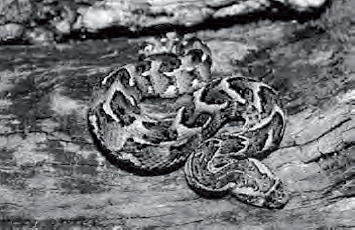
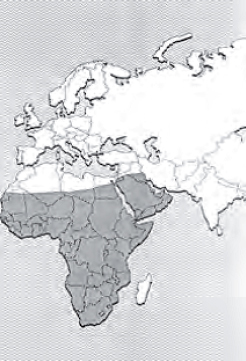
Description: Yellowish, light brown, or orange with chevron-shaped dark brown or black bars.
Characteristics: The puff adder is the second-largest of the dangerous vipers. It is one of the most common snakes in Africa. It is largely nocturnal, hunting at night and seeking shelter during the day’s heat. It is not shy when approached. It draws its head close to its coils, makes a loud hissing sound, and is quick to strike any intruder. Its venom is strongly hemotoxic, destroying bloods cells and causingextensive tissue damage.
Habitat: And regions to swamps and dense forests. Common around human settlements.
Length: Average 12 meters, maximum 1.8 meters.
Distribution: Most of Africa, Saudi Arabia, Iraq, Lebanon, Israel, and Jordan.
Rhinoceros viper or river jack
Bitis nasicornis
Description: Brightly colored with purplish to reddish-brown markings and black and light olive markings along the back. On its head it has a triangular marking that starts at the tip of the nose. It has a pair of long horns (scales) on the tip of its nose.
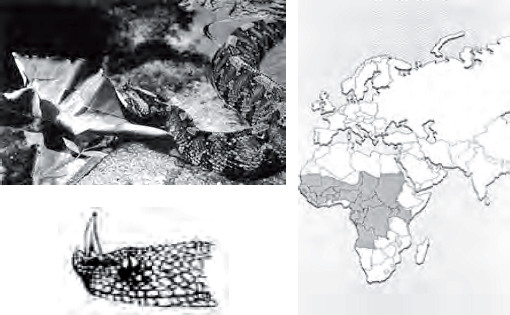
Characteristics: Its appearance is awesome; its horns and very rough scales give it a sinister look. It has an irritable disposition. It is not aggressive but will stand its ground ready to strike if disturbed. Its venom is neurotoxic and hemotoxic.
Habitat: Rain forests, along waterways, and in swamps.
Length: Average 75 centimeters, maximum 1 meter.
Distribution: Equatorial Africa.
Russell’s viper
Vipera russellii
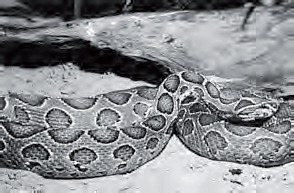
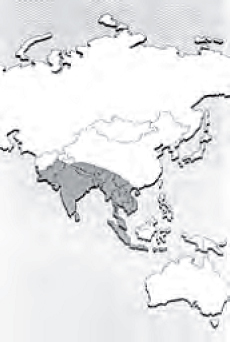
Description: Light brown body with three rows of dark brown or black splotches bordered with white or yellow extending its entire length.
Characteristics: This dangerous species is abundant over its entire range. It is responsible for more human fatalities than any other venomous snake. It is irritable. When threatened, it coils tightly, hisses, and strikes with such speed that its victim has little chance of escaping. Its hemotoxic venom is a powerful coagulant, damaging tissue and blood cells.
Habitat: Variable, from farmlands to dense rain forests. It is commonly found around human settlements.
Length: Average 1 meter, maximum 1.5 meters
Distribution: Sri Lanka, south China, India, Malaysian Peninsula, Java, Sumatra, Borneo, and surrounding islands.
Sand viper
Cerastes vipera
Description: Usually uniformly very pallid, with three rows of darker brown spots
Characteristics: A very small desert dweller that can bury itself in the sand during the day’s heat. It is nocturnal, coming out at night to feed on lizards and small desert rodents. It has a short temper and will strike several times. Its venom is hemotoxic.
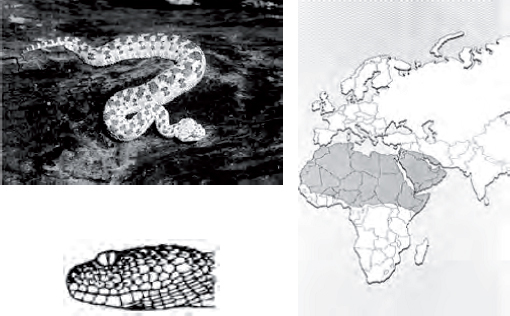
Habitat: Restricted to desert areas.
Length: Average 45 centimeters, maximum 60 centimeters.
Distribution: Northern Sahara, Algeria, Egypt, Sudan, Nigeria, Chad, Somalia, and central Africa.
Saw-scaled viper
Echis carinatus
Description: Color is light buff with shades of brown, dull red, or gray. Its sides have a white or light-colored pattern. Its head usually has two dark stripes that start behind the eye and extend to the rear.
Characteristics: A small but extremely dangerous viper. It gets the name saw-scaled from rubbing the sides of its body together, producing a rasping sound. This ill-tempered snake will attack any intruder. Its venom is highly hemotoxic and quite potent. Many deaths are attributed to this species.
Habitat: Found in a variety of environments. It is common in rural settlements, cultivated fields, arid regions, barns, and rock walls.
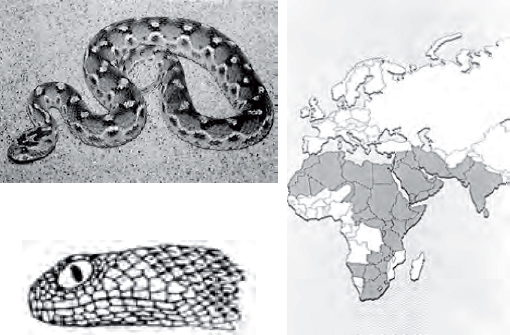
Length: Average 45 centimeters, maximum 60 centimeters.
Distribution: Asia, Syria, India, Africa, Iraq, Iran, Saudi Arabia, Pakistan, Jordan, Lebanon, Sri Lanka, Algeria, Egypt, and Israel.
Wagler’s pit viper or temple viper
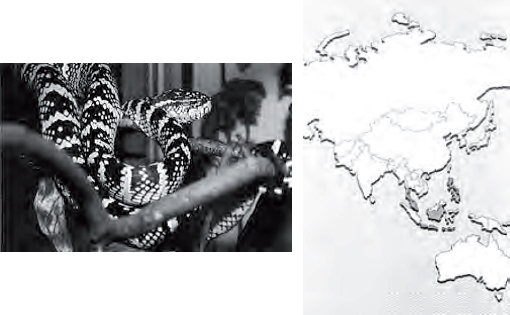
Trimeresurus wagleri
Description: Green with white crossbands edged with blue or purple. It has two dorsal lines on both sides of its head.
Characteristics: It is also known as the temple viper because certain religious cults have placed venomous snakes in their temples. Bites are not uncommon for the species; fortunately, fatalities are very rare. It has long fangs. Its venom is hemotoxic causing cell and tissue destruction. It is an arboreal species and its bites often occur on the upper extremities.
Habitat: Dense rain forests, but often found near human settlements.
Length: Average 60 centimeters, maximum 100 centimeters.
Distribution: Malaysian Peninsula and Archipelago, Indonesia, Borneo, the Philippines. and Ryuku Islands.
POISONOUS SNAKES OF AUSTRALASIA
Australian copperhead
Denisonia superba
Description: Coloration is reddish brown to dark brown. A few from Queensland are black.
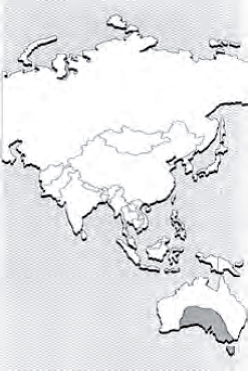
Characteristics: Rather sluggish disposition but will bite if stepped on. When angry, rears its head a few inches from the ground with its neck slightly arched. Its venom is neurotoxic.
Habitat: Swamps.
Length: Average 1.2 meters, maximum 1.8 meters.
Distribution: Tasmania, South Australia, Queensland, and Kangaroo Island.
Death adder
Acanthophis antarcticus
Description: Reddish, yellowish, or brown color with distinct dark brown crossbands. The end of its tail is black, ending in a hard spine.
Characteristics: When aroused, this highly dangerous snake will flatten its entire body, ready to strike over a short distance. It is nocturnal, hiding by day and coming out to feed at night. Although it has the appearance of a viper, it is related to the cobra family. Its venom is a powerful neurotoxin; it causes mortality in about 50 percent of the victims, even with treatment.